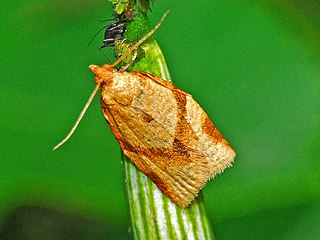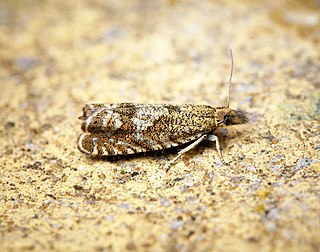
Zygaena carniolica, sometimes described as the crepuscular burnet or eastern burnet, is a member of the family Zygaenidae.

Dichrorampha acuminatana is a moth of the family Tortricidae. It is found in Europe and the Near East.

Clepsis consimilana, the privet tortrix, is a moth of the family Tortricidae.

Sabatinca doroxena is a species of moth belonging to the family Micropterigidae. It is endemic to the North Island of New Zealand. This small moth has a colourful forewing pattern with stripes and dots evident. It has been hypothesised that the forewing pattern is intended to resemble a jumping spider in order to allow the adult moth to escape predation. Adults of this species are on the wing from the beginning of September until mid January. It prefers damp but sunny habitat in deep forest, at the forest edge or in open shrubland. Larvae feed on foliose liverwort species including on Heteroscyphus normalis. Adults of this species have been located at the blossoms of flowering Cordyline and Ranunculus species.

Dichrorampha alpinana, the broad-blotch drill, is a species of moth of the family Tortricidae. It is found in almost all of Europe.

Dichrorampha vancouverana, the tanacetum root moth, is a moth of the family Tortricidae.

Rhopobota stagnana is a moth belonging to the family Tortricidae. The species was first described by Michael Denis and Ignaz Schiffermüller in 1775.

Grapholita lunulana is a moth belonging to the family Tortricidae. The species was first described by Michael Denis and Ignaz Schiffermüller in 1775.

Lobesia reliquana is a moth belonging to the family Tortricidae. The species was first described by Jacob Hübner in 1825.

Pammene obscurana is a moth belonging to the family Tortricidae. The species was first described by James Francis Stephens in 1834.

Pammene rhediella is a moth belonging to the family Tortricidae. The species was first described by Carl Alexander Clerck in 1759.

Pammene splendidulana is a moth belonging to the family Tortricidae. The species was first described by Achille Guenée in 1845.

Dichrorampha aeratana is a moth belonging to the family Tortricidae. The species was first described by Pierce and Metcalfe in 1915.
Dichrorampha agilana is a moth belonging to the family Tortricidae first described by Johan Martin Jakob von Tengström in 1848.
Dichrorampha flavidorsana is a moth belonging to the family Tortricidae subfamily Olethreutinae Tribe Grapholitini first described by Henry Guard Knaggs in 1867.
Dichrorampha incognitana is a moth belonging to the family Tortricidae. The species was first described by Jerzy Kremky and Maslowski in 1933.

Dichrorampha plumbagana is a moth belonging to the family Tortricidae first described by Georg Friedrich Treitschke in 1830.

Dichrorampha plumbana is a moth belonging to the family Tortricidae first described by Giovanni Antonio Scopoli in 1763. It is native to the Palearctic including Europe.
Dichrorampha senectana is a moth belonging to the family Tortricidae first described by Achille Guenée in 1845.
Dichrorampha sylvicolana is a moth belonging to the family Tortricidae. The species was first described by Hermann von Heinemann in 1863.















